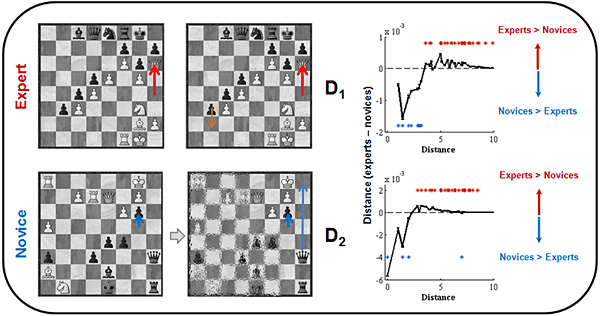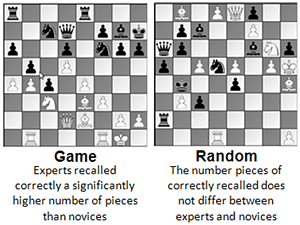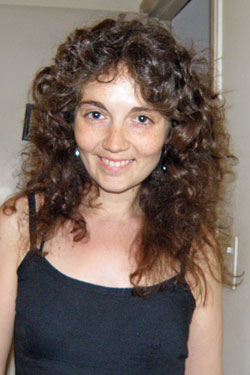
The geometry of expertise
By Maria Juliana Leone and Mariano Sigman
Abstract: Chess is a widely used model of human expertise. Chess experts can quickly recognize candidate moves and correctly recall a chess position much better than novices: chess experts “see” the board differently. We hypothesized that the internal representation of the board depends on the chess skill: chess experts rely less in spatial proximity and more in functional relationships. Our results showed that experts play over the whole board, make less piece repetitions and delay piece exchanges, in contrast with novices.
Space and object-based attentional mechanisms
Experts can see shapes, patterns, structures in their domain of expertise. These patterns do not follow conventional perceptual Gestalt rules where objects are grouped by proximity, similarity... This is, of course true in chess, one of the most widely studied models of expertise.
Chess experts rely in heuristics that allow them to focus (and literally see) only a few “good enough” moves (de Groot, 1978). When asked how many moves ahead he looks, Capablanca answered "only one, the best one." Chase, Simon and Gobet (Chase and Simon, 1973; Gobet and Simon, 1996) coined the notion of chunking theories, by which experts perceive groups of pieces functionally related as a whole. This is a form of syntax in the chess board which allows chess players to remember complex positions easily as the majority of the people can remember the songs of The Beatles.

Classical works on chess expertise
-
A) Good players focus on the better moves. Adriaan de Groot asked chess players to find the best move on several positions, but thinking aloud. The participants were players with different levels of expertise, including GM Alexander Alekhine who after nine minutes said “Well, in case of time pressure I would play 1.BxNd5” (de Groot, 1978).
-
B) Chunking theory. Chase, Simon and Gobet made some experiments were players with different chess skill have to recall chess positions with the piece located correctly or randomly on the board. They found that high rated players recall higher number of pieces than low rated players only if the pieces are located logically according to the chess rules (Chase and Simon, 1973; Gobet and Simon, 1996). Modified from Gobet et al., 2001.
Chunk and template theories suggested the existence of geometrical differences in the organization of a chess board in the expert mind. Expert representation of the board is not organized based on the real distance between two pieces but it is instead dictated by the chess relationship between them. For instance, a bishop in c2 which works in concert with a queen in h3 to jointly attack h7 square may be “functionally proximal” pieces in the mind of an expert, but “functionally distal” in the mind of a novice who does not recognize this relation.
We reasoned that the movement of an opponent piece to a specific square constitutes an external attentional cue. The reaction of the player to this “perturbation” should reveal his internal representation of proximity. Specifically, we hypothesized (Hypothesis 1) that a novice player will tend to respond in proximal squares. Instead, expert player responses will be less likely to be governed by the spatial position of the opponent last move. Moreover, when we think on this argument but based on objects (those objects – pieces – which will capture our attention), we hypothesized that a novice player will more likely direct attention (concentrate) to a specific piece and hence produce repeated sequence of moves with the same piece (Hypothesis 2). Instead, expert representation is directed to a more sophisticated pattern of pieces (chains of pawns, coordinated set of pieces working in concert…) and hence the sequence of moves should show fewer repetitions.
Additionally, if weak players focus more on individual pieces, we expected a tendency to reduce the number of objects to be attended to avoid cognitive load (Hypothesis 3). Finally, we predicted that experts would play in line with general strategic principles (e.g., centralization of knights and rooks). We tested our hypotheses using massive sets data available from free Internet chess servers (FICS). We analyzed more than 350,000 games from players of two levels (based on their rating) playing against players of the same level with a time budget of 3, 5 and 15 minutes per player without increment.
Hypothesis 1
Low rated players make moves which are more proximal to their own last move (D1) and to the opponent precedent move (D2).
To test this hypothesis we used two distance measurements: D1 measures the distance between the final location of a movement and the final location of the previous opponent movement. D2 measures the distance between the final locations of two consecutive moves of the same player. Short distances reflect proximal movements. Long distances, distal movements.

Distance measurements
Player A and B are playing a game through an Internet chess server. Player A makes a move. Player B responded. Distance between the final locations of these last two moves is defined as D1. If we look also the next move of the player A, we can calculate the distance between the final locations of the two moves of player A, which is D2.
As it is shown in the figure, the comparison of distances found for novices and expert players showed that low rated players made more frequently short or proximal movements (both relative to their opponent previous movement or to their own previous movement). Experts can “see” the whole board but the novices gaze is engaged in the region where the last movement was made.

Examples of D1 and D2 for an expert and for a novice
Left boards show the position and the last movement. Right boards show the same, but also illustrating which region of the board is hypothetically considering the player (for D1, the opponent; for D2, the same player). Note that the expert will see the whole board and will play independently of the cued region (the en location of the previous movement). When a novice evaluates their next movement (D2), he/she continues engaged by his/her previous movement considering that he/she will mate his/her opponent (but note that the Bh7 will save the position). These examples illustrate our main results: on both D1 and D2 comparisons, we found more short distance movements for novices and more long distances movements for experts.
Hypothesis 2
Low rated players are more likely to move the same piece in consecutive turns.
The previous results suggest that low rated players have a narrower (or more focal) spatial window of attention (cannot see the whole board but a region of it). Attention can be directed to space, but also to objects. Then, we analyzed if novices continued engaged with the “same object” (see the parallel with the “same region”) cued by the previous movement: we predict that novices will repeat the same piece in consecutive turns more frequently than experts. Importantly, the probability of moving the same piece twice depends on the number of pieces remaining of the board. Thus, we calculated it depending on the number of pieces remaining in the board. As it is shown in the figure, piece repetition is significantly lower for experts independently on the remaining number of pieces.

Novices make more piece repetitions than experts, independently of the number of remaining pieces on the board. Asterisks indicate statistically significant differences between the groups: blue ones, higher piece repetition for novices and red ones, for experts. Figure as originally published in Leone MJ, Fernandez Slezak D, Cecchi GA and Sigman M (2014) The geometry of expertise. Front. Psychol. 5:47. doi: 10.3389/fpsyg.2014.00047.
Hypothesis 3
Since weak players focus more on individual pieces it is expected that it is effortful for them to work on boards with many pieces. We expect that weaker players will tend to simplify the position to avoid mental effort.
This hypothesis predicts that novices will reduce the number of pieces over the board because is cognitively expensive for them to manage multiple objects at the same time. Then, we analyzed the number of remaining pieces on the board along the whole game.

Novices exchange pieces more quickly. Along the whole game, the number of remaining pieces on the board is higher for experts. This result shows that novices exchange pieces more quickly than experts, reducing the number of objects to be attended. Figure as originally published in Leone MJ, Fernandez Slezak D, Cecchi GA and Sigman M (2014) The geometry of expertise. Front. Psychol. 5:47. doi: 10.3389/fpsyg.2014.00047.
Previous figures showed results for three minute games, but similar results were obtained for longer time budgets (5 and 15 min per player). These complementary results as well as the comparison of location of pieces over the board can be consulted in the original work (Leone et al., 2014).
The results described above show that weaker players tend to produce consecutive moves in proximal board locations, more often moving the same piece and exchanging pieces more rapidly to reduce the number of remaining pieces. These three principles reflect consistent general findings which might reflect the effect of expertise on human actions in complex setups.
Links
Citations
- Chase WG, and Simon, HA (1973). Perception in chess. Cogn. Psychol. 4, 55–81.
- de Groot, AD (1978). Thought and Choice in Chess (2nd. Edn.). New York, NY: Mounton De Gruyter.
- Gobet, F and Simon, HA (1996). Templates in chess memory: a mechanism for recalling several boards. Cogn. Psychol. 31, 1–40.
- Gobet F Lane PCR., Croker S, Cheng PCH., Jones G, Oliver I, Pine JM (2001). Chunking mechanisms in human learning. TICS. 5:6, 236-243.
About the authors
María Juliana Leone was born in Argentina. She got a major in Biotechnology and a PhD in Basic and Applied Sciences, working in Chronobiology at University of Quilmes. Since 2004, she teaches Biochemistry in this University. Before starting her degree studies, she played chess in national and international tournaments, obtaining the Woman International Master title in 1999. Before graduating, she worked for a year and a half in the Club Argentino de Ajedrez, where Alekhine beated Capablanca in 1927. After her PhD, she could bind her old love (chess) with her work in the Integrative Neuroscience Laboratory, where she currently is doing a postdoc on physiological correlates of decision-making, using chess as a model.
Mariano Sigman was born in Argentina, grew up in Barcelona and came back to Buenos Aires where he got a major in physics. He moved to New York to do a PhD in neuroscience, focusing on visual perception, on the physiology and psychophysics of perceptual learning. He then moved to Paris, to investigate decision making, consciousness and cognitive architecture. In 2006 he came back (again) to Argentina, as a professor in the Physics Department, where he currently is the director of the Integrative Neuroscience Laboratory. He has very broad interests in cognition including consciousness metacognition and introspection, cognitive development, language and conceptual networks, problem solving, educational neuroscience... He has been awarded the Human Frontiers Science Program and the James S McDonnell Foundation career development awards. He has an extensive career on science popularization, has written hundreds of articles, books, hosts a radio show and participated in several television shows. He is a chess aficionado, a compulsive reader of chess psychology and, unfortunately, a very bad player. He tweets at @mariuchu. Mariano conducted an interview for ChessBase back in 2003.
Copyright Maria Juliana Leone and Mariano Sigman/ChessBase































